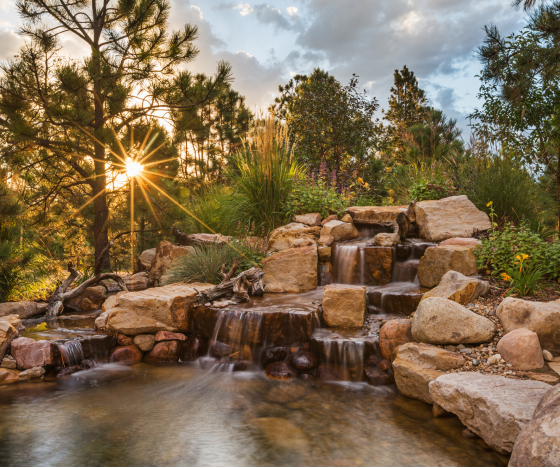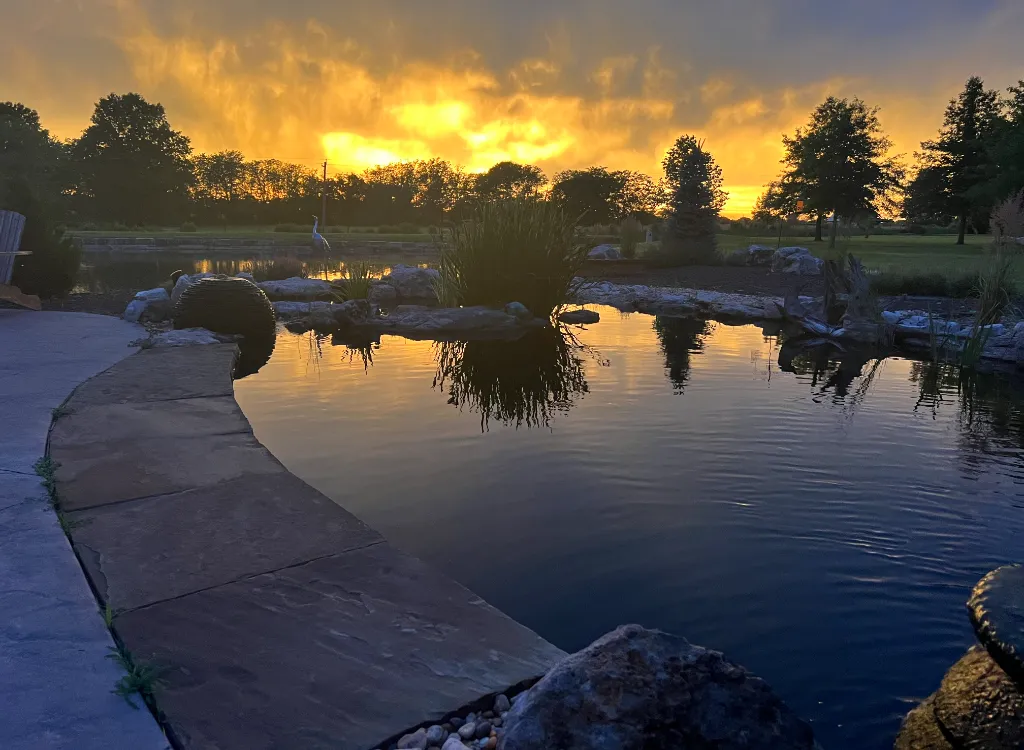
If you’re the proud owner of a backyard pond, you know the importance of keeping it clean and healthy. This guide will explore three different natural pond filtration methods and teach you how to keep a natural pond clean.
Maintaining a healthy pond ecosystem requires a filtration system to remove waste and keep the water clear. However, traditional koi pond filters can be expensive and require a lot of maintenance. Fortunately, there are several natural options available that are both affordable and low-maintenance.
We’ll also provide some tips on how to get started with natural filtration and maintain your pond’s health throughout the year.
So whether you’re just starting or are looking for new ways to improve your pond’s health, read on for all the information you need!
Cleaning A Pond The Natural Way
Most people think ponds are dirty and full of algae, but that doesn’t have to be the case. You can do a few things to keep your pond clean and clear all year long.
Read on to discover some simple steps you can take to ensure your pond stays clean the natural way.
Remove Organic Debris
As any pond owner knows, organic debris is one of the main culprits when it comes to pond pollution. So one of the most important things you can do is regularly remove organic waste such as leaves and branches. This debris can decompose and release excess nutrients into the pond water, leading to algae growth.
Algae can not only make your pond look murky, but it can also deplete oxygen levels, harming fish and other aquatic life. Organic debris can also provide a breeding ground for mosquitoes and other pests. Regularly removing organic debris can help ensure that your pond stays clean and healthy for years to come.
Pond Net
There are a few different ways to do this. One option is to use a pond net to remove the water’s debris physically. This method is particularly effective for larger ponds.
You can use a net to skim the pond’s surface and carefully rake the bottom of the pond. You can also use a pond vacuum to remove debris from the bottom of the pond.
Pond Skimmer
Another option is to install a pond skimmer, which will help to collect smaller pieces of debris before they have a chance to decompose. Skimmers typically consist of a net attached to a floating frame, and they are often used in conjunction with a pump to create a vigorous circulation of pond water.
Pond skimmers are essential for keeping ponds clean, as they remove leaves, twigs, and other organic matter that can fall into the water. Skimmers also help to aerate the pond water and prevent the build-up of algae.
Beneficial Bacteria
Although there are a variety of chemicals you can use to kill algae and unwanted plants, these can be harmful to the fish and other creatures in the pond. Fortunately, there are also many beneficial bacteria you can add to the pond water to help keep it clean.
These bacteria consume the waste produced by the fish and other organisms, helping to keep the water clear. They also help to break down dead plants and leaves, which can add nutrients to the water and promote the growth of desirable plants.
Beneficial bacteria also help to oxygenate the water, creating a healthy environment for fish and other aquatic plants. Adding beneficial bacteria to your pond keeps it clean and healthy without resorting to harsh chemicals.
While many different beneficial bacteria types are available, choosing those specifically designed for ponds is essential. Using pond-specific bacteria will ensure that the bacteria are effective in keeping your pond clean and healthy.
Beneficial bacteria are available from many pond supply stores. Adding beneficial bacteria to your pond can help keep it clean and clear all season long.
Keep reading for information on biological filtration, one of the most important methods for keeping your pond healthy.
Biological Filtration
Biological filtration is a natural process that helps to keep ponds clean by removing these waste products from the water. The main benefits of biological filtration are that it helps to improve water quality and clarity and reduces the risk of disease. Biological filtration can also help to control nuisance algae growth.
How Does Biological Filtration Work?
Biological filtration occurs when bacteria and other organisms break down organic matter, such as leaves and dead fish, into simpler molecules.
This process helps to remove ammonia and other harmful chemicals from the water, making it safer for plants and animals. Biological filtration also aids in producing oxygen, which is essential for healthy pond ecosystems.
Use Biological Filters
A biological filter is essential to keeping a pond clean and healthy. The filter uses bacteria to break down waste products in the water, such as ammonia and nitrites. This process helps to keep the water clear and free of harmful toxins.
Biological filters can be either standalone units or integrated into the pond itself. Biological filters come in various shapes and sizes, but they all work by providing a surface area for beneficial bacteria to colonize.
There are several different types of biological filters that you can use in your pond. The type of filter that you use will depend on the size of your pond and the number of fish you have.
Here are some of the most common types of biological filters:
Sponge Filters
The most common type of biological filter is a sponge filter, which consists of a plastic container filled with sponges. Water is pumped through the sponges, where the bacteria can grow and multiply. The water then flows out of the filter and back into the pond.
Gravel Bed Filters

Another type of biological filter is a gravel bed filter. This type of filter uses gravel as the medium for bacterial growth. Gravel bed filters are typically used in larger ponds or aquaculture facilities.
Power Filters
A power filter for ponds is a great way to keep your pond clean and free of debris. There are a few different types of power filters, but they all work to remove unwanted particles from the water. Some power filters are submersible, while others are designed to be placed on the edge of the pond. Power filters can be used in conjunction with other pond filtration systems, or they can be used alone.
Power filters work by drawing water into the filter and then trapping the debris in a filtering material. The filtered water is then returned to the pond. Power filters can remove various types of debris, including leaves, twigs, and even small stones. Pond power filters can effectively keep your pond clean and clear, and they are relatively easy to maintain.
Canister Filters
A canister filter for ponds is vital for keeping your pond clean and preventing the build-up of algae and other debris. Canister filters are designed to be placed under the water, where they keep the water circulating and aerated.
Water circulation and aeration help to prevent stagnant water and keep oxygen levels high. Oxygen is essential for the health of fish and other aquatic organisms. Canister filters also trap debris and particles, allowing you to remove them from the water before they have a chance to decompose and pollute the pond.
Pressurized Diatomaceous Earth (DE) Filters
Pressurized diatomaceous earth (DE) filter is one of the most effective ways to keep a natural pond clean. DE is a powder made from the fossilized remains of algae-like organisms called diatoms.
When mixed with water, this powder forms a thick, sticky slime that can trap small debris particles. As water passes through a DE filter, the debris is trapped in the slime and removed from the pond.
Pressurized DE filters are designed to work with a pump and can be used to filter large volumes of water. While they are more expensive than other types of pond filters, they are very effective at keeping ponds clean and clear.
If you’re not sure which type of filter is right for your pond, we recommend consulting with a professional. A professional can recommend the best option for your specific situation.
Keep reading to learn more about natural pond plant filtration.
Natural Pond Plant Filtration
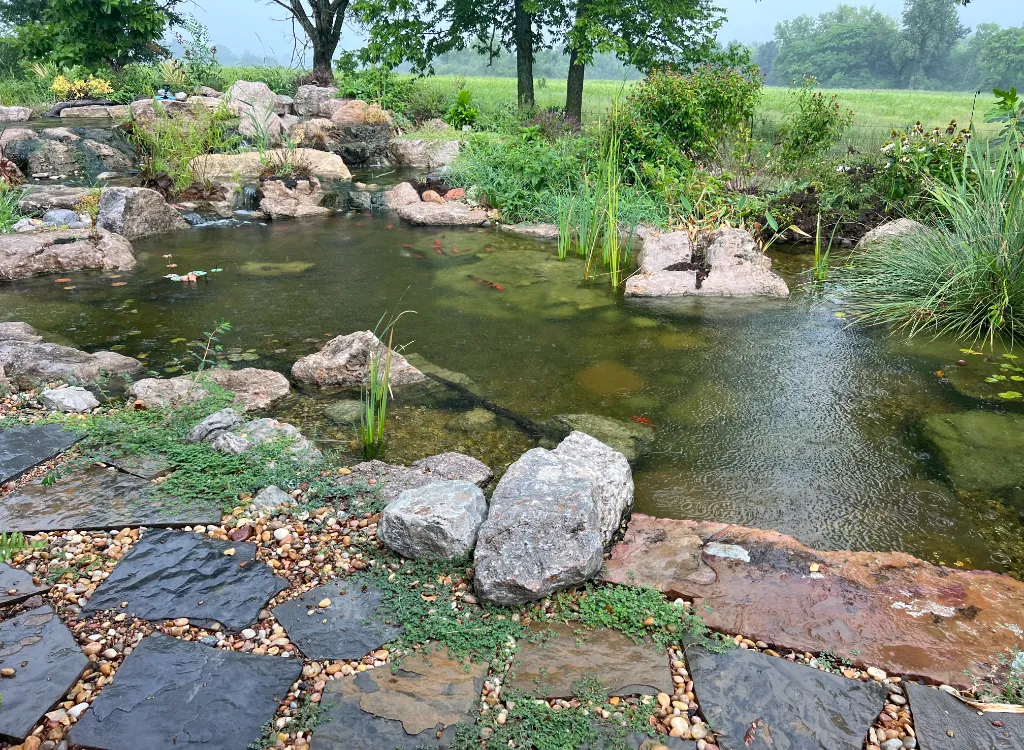
A natural pond is beautiful, providing a refuge for wildlife and a serene spot for you to enjoy. But how do you keep a natural pond clean? One meaningful way is through natural pond plant filtration.
Plants play an essential role in keeping your pond healthy. They help to absorb excess nutrients and water, which can otherwise lead to algae growth. Plants also help to oxygenate the water, providing a vital element for fish and other aquatic creatures.
Perhaps most importantly, plants help filter out pollutants and debris from the water. By creating a robust filtration system consisting of different plants, you can be sure that your pond stays clean and healthy for years to come.
Pond Plants
A critical factor in keeping a natural pond clean is a good balance of different types of beneficial pond plants. The best way to do this is to choose native plants known for their ability to outcompete algae. Plants play a crucial part in maintaining water quality.
Plants absorb nutrients from the water that would otherwise contribute to algae growth. They also provide shelter and food for fish and other aquatic creatures. Plants also release oxygen into the water through photosynthesis, which helps to aerate the water and prevent stagnation.
Make sure you also have plenty of plants around the pond’s perimeter. These will also help to filter the water and keep the pond clean.
There are many different types of plants that can be used for filtration. Each type of plant has its benefits and should be chosen based on the specific needs of your pond.
However, most pond plants fall into three general categories: submerged, floating, and emergent. The best strategy for most natural ponds is to include a mix of submerged, floating, and emergent plants in your pond.
Keep reading to discover the benefits of each plant type and some of the most popular ones people use for natural filtration.
Submerged Plants
Submerged plants are plants that grow under the water’s surface. They help keep ponds clean by absorbing excess nutrients from the water, which would otherwise cause an algae bloom. Submerged plants also release oxygen into the water, improve water clarity, and provide a habitat for fish and other aquatic creatures.
When choosing these plants for your pond, be sure to select species that are native to your area, and that will do well in the specific conditions of your pond (e.g., depth, sun exposure).
The best way to find out what plants work best in your area is to consult a professional pond contractor or native plant specialist.
Some of the most common submerged plants include:
-Watermilfoil (Myriophyllum spicatum)
-Eurasian watermilfoil (Myriophyllum spicatum)
-Creeping water primrose (Ludwigia peploides)
-Dwarf watchman fern (Pellaea atropurpurea)
-Creeping Jenny (Lysimachia nummularia)
-Hornwort (Ceratophyllum demersum)
Floating Plants
A floating plant is an aquatic plant that grows on or near the surface of a body of water. Commonly found in ponds, these plants play an essential role in maintaining water quality.
They help to shade the water, which reduces algae growth, and their roots act as natural filters, trapping fish waste and providing a home for beneficial bacteria. Floating plants also help to oxygenate the water and provide shelter for fish and other aquatic creatures.
As a result, adding a few floating plants to your pond can be an effective way to keep it clean and healthy. Again, you should always consult with a professional to ensure you are using plants native to your area and not introducing invasive plant species.
Some of the most common floating plants include:
-Water hyacinth (Eichhornia crassipes)
-Water lettuce (Pistia stratiotes)
-Yellow floating heart (Nymphoides peltata)
-Fragrant waterlily (Nymphaea odorata)
-Yellow lotus (Nelumbo lutea)
-Floating fern (Salvinia natans)
-Water pennywort (Hydrocotyle vulgaris)
Emergent Plants
While submerged plants grow entirely underwater, and floating plants float freely on the water surface, emergent plants grow out of the water. Emergent plants are an excellent option for ponds because they grow in shallow water, and their roots help to stabilize the soil.
Like floating and submerged plant types, emergent plants help shade the pond and prevent algae growth. They can also provide food and habitat for fish, frogs, and other aquatic creatures. As a result, emergent plants play an essential role in keeping your pond water healthy.
Some of the most common emergent plants include:
-Cattails (Typha species)
-Rushes (Juncaceae)
-Sedges (Cyperaceae)
-Pickerel Rush (Pontederia cordata)
-Arrowhead (Syngonium podophyllum)
Many of these plants are prolific growers, so you must keep an eye on them and trim them back as needed to prevent them from taking over your pond.
Now that we’ve covered the various plants that can help keep your pond naturally clean let’s look at some beneficial fish species for your pond.
Fish
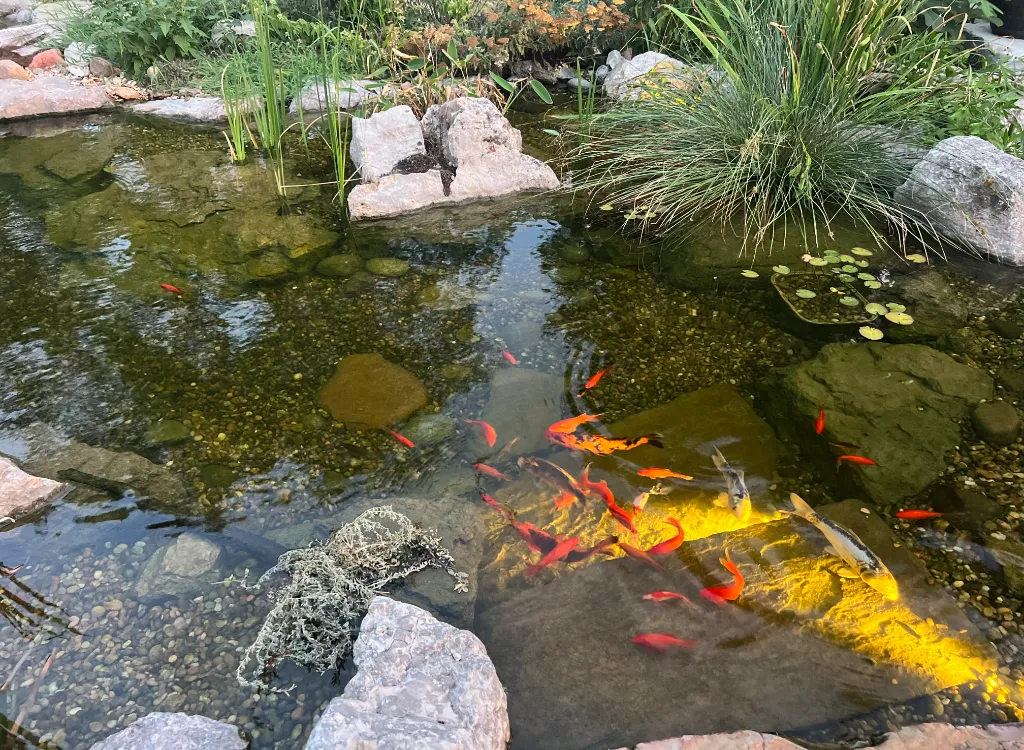
Fish play an essential role in keeping your pond naturally clean and healthy. By swimming around, they help to circulate the water and keep it well-oxygenated.
As predators, fish help to control the population of algae and aquatic plants. This aspect of fish is important because too much algae can lead to decreased oxygen levels in the water, which can harm fish and other marine wildlife.
Fish also consume large quantities of dead leaves and other organic matter, helping to keep the water clean and clear. As a result, a healthy population of fish can play an essential role in maintaining a clean pond.
There are many factors to consider when selecting fish for your pond, including climate, pond size, and predators. In general, goldfish and koi are some of the most popular choices for ponds. While lesser known than goldfish or koi, we recommend stocking your pond with golden orfe.
Here’s a quick rundown of the benefits of each of these popular species of pond fish:
Goldfish
Goldfish eat algae and help to aerate the water, which helps to keep the pond healthy. They also consume dead plant matter, which can help to improve water quality.
Goldfish produce waste that contains nutrients that are beneficial to aquatic plants. Perhaps best of all, goldfish eat mosquito larvae, helping control these pesky insects’ population.
Goldfish are relatively hardy and can withstand a wide range of temperatures, making them ideal for cold and warm climates.
Koi
Koi are filter feeders, which means they eat algae and other tiny organisms that can clog a pond and make it difficult for plants to grow. As a result, adding koi to your pond can help to keep it clear and healthy.
Koi are pretty popular, as they are beautiful fish that come in a wide range of colors. In fact, there are over 100 types of koi! If you want to learn more about the different types of this popular fish, check out our guide to the 11 most common types of koi fish.
However, koi can also be more challenging to care for than goldfish and require a larger pond to thrive.
Golden Orfe
A more economical option is the golden orfe. This hardy fish is easy to care for and does an excellent job of filtering pond water. Golden orfe are famous for their bright golden coloration, ranging from pale lemon to deep gold.
Golden orfe are scavengers, meaning they feed on algae, dead plants, and other organic matter. Scavenging helps to keep the pond clean and clear by preventing the build-up of debris on the bottom. Golden orfe also produces less waste than other fish, which further helps to keep the water quality high.
Since they are such good cleaners, golden orfe is often used in ponds that contain other fish species. Not only do they help to keep the pond clean, but they also provide an essential food source for their fellow fish. The golden orfe is an excellent option if you want to add fish to your natural pond.
Bog Gravel Filtration
Bog gravel filtration is another natural way to filter your pond water. Bog gravel is a type of gravel often used in aquariums and ponds because it is chemically inert and does not affect pH levels.
How Bog Gravel Filtration Works
Bog gravel filters use bacterial colonies that live on the surface of the gravel to break down debris, algae, fish waste, and other unwanted particles from the water.
The process is simple: water flows into the bog gravel filter, which is then filtered through the gravel and returned to the pond. This method is often used in ponds with fish, as it helps keep the water clean and clear.
How To Make Your Own Bog Gravel Filtration System
To build a bog gravel filtration system, you will need to excavate an area of the pond shoreline and add a layer of gravel.
Be sure to use stones that are small enough to fit through the gaps in the gravel so that water can flow freely through the system.
Once you have added the gravel, you can add plants that will help filter the water and provide shelter for wildlife.
The bog gravel media alone will not eliminate all existing waste in your pond; however, it will help reduce waste levels over time and prevent new waste from entering the pond. It should also help reduce your overall pond maintenance.
Bog gravel filters are most effective when used in conjunction with other filtration methods, such as mechanical filtration.
By incorporating one or more of the techniques mentioned above into your pond-cleaning routine, you’ll keep your water sparkling clean while preserving its delicate ecosystem.
Contact Gradex Company
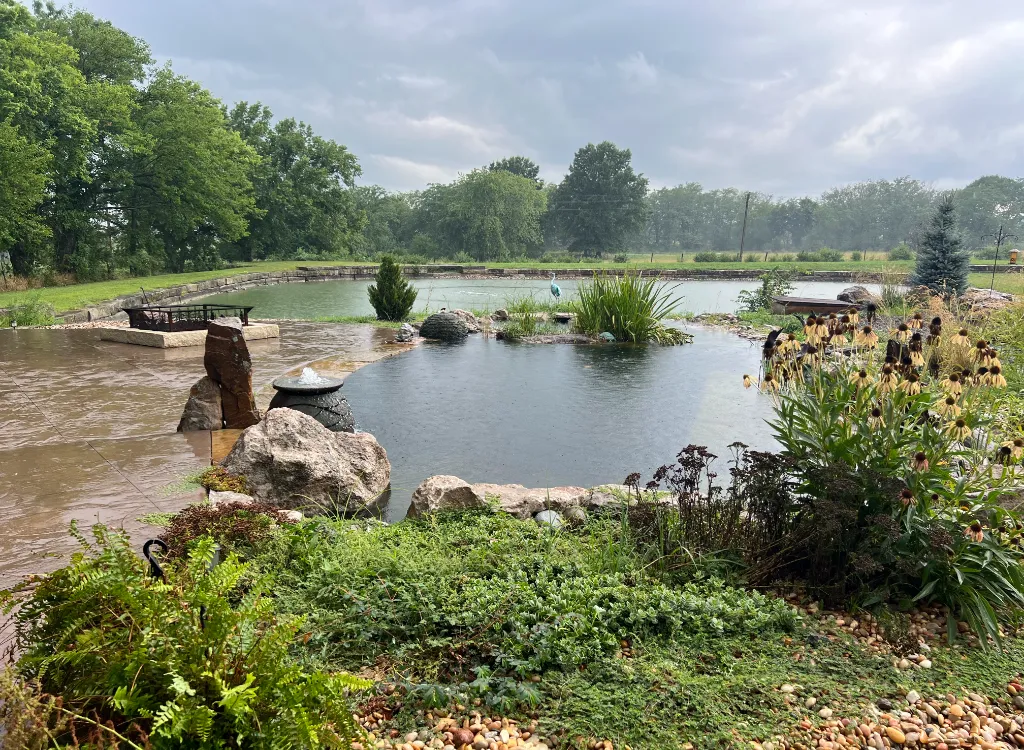
There are several different ways that you can naturally filter your pond water. This blog post discussed three of the most popular methods: biological filtration, natural pond plant filtration, and bog gravel filtration.
If you have any questions about pond maintenance or need help getting a natural pond started, we are here to help! Fill out our contact form today, and let us help you keep your pond naturally clean.
